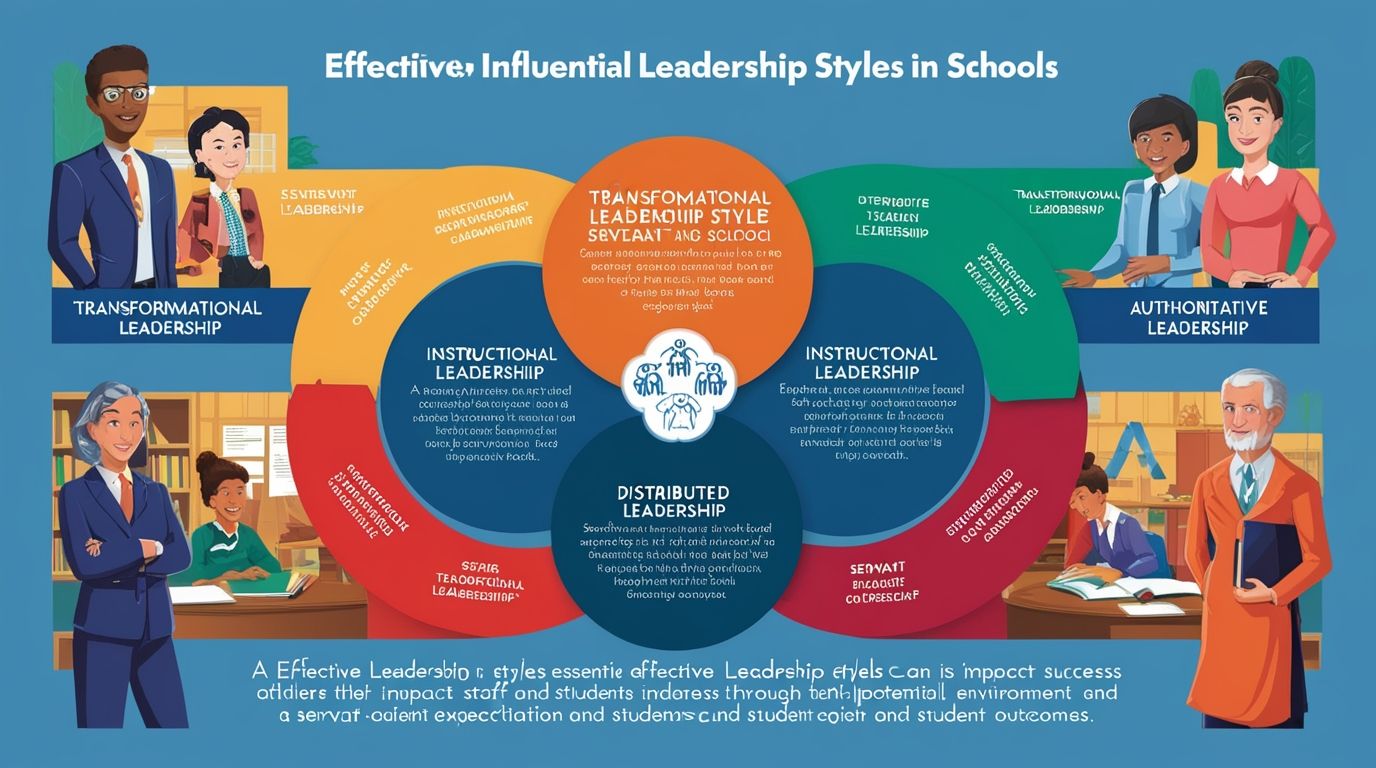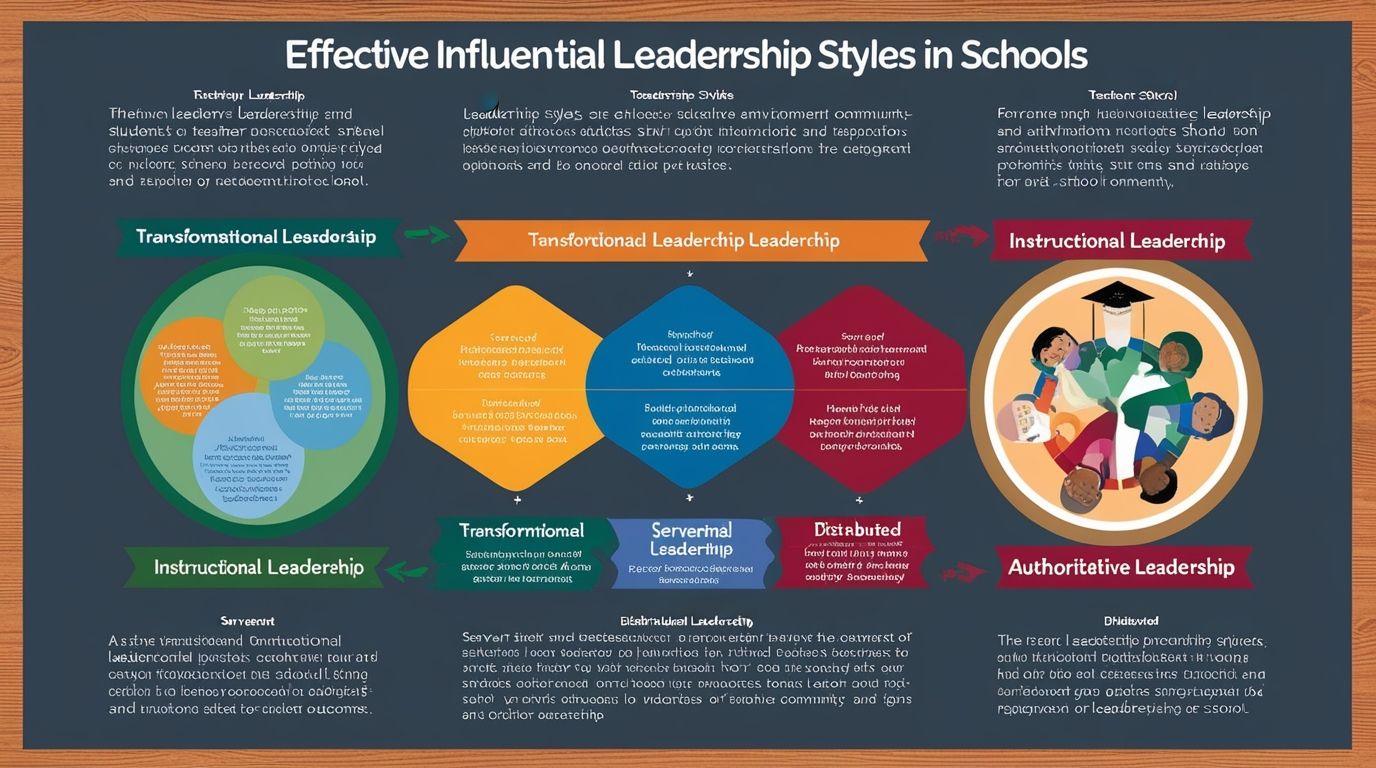Introduction
Influential Leadership Styles in Schools, Leadership in schools plays a pivotal role in shaping the educational landscape. Effective leadership not only influences the academic success of students but also the overall school environment, teacher morale, and community engagement. Understanding influential leadership styles can provide insights into how school leaders can foster a positive and productive learning environment.
Leadership Styles in Schools
1. Transformational Leadership
Definition: Transformational leadership is characterized by leaders who inspire and motivate their followers to exceed their own self-interests for the good of the organization and its goals. This style is often associated with visionaries who drive change through inspiration and commitment.
Key Characteristics:
- Vision and Inspiration: Transformational leaders have a clear vision for the future and communicate this vision compellingly.
- Empowerment: They empower teachers and staff by involving them in decision-making processes.
- Commitment to Professional Development: They prioritize ongoing professional development to help staff achieve their potential.
- Impact on Schools: Transformational leadership fosters a collaborative school culture where teachers feel valued and motivated. This leads to increased teacher retention, enhanced job satisfaction, and improved student outcomes. By inspiring teachers, transformational leaders cultivate an environment of continuous improvement and innovation.

2. Instructional Leadership
Definition: Instructional leadership focuses on improving teaching and learning. Leaders in this style deeply involved in the curriculum, instruction, and assessment practices within the school.
Key Characteristics:
- Focus on Learning: Instructional leaders prioritize student learning and achievement.
- Curriculum Expertise: They possess a strong understanding of curriculum and instructional strategies.
- Data-Driven Decision Making: These leaders use data to inform instructional practices and interventions.
- Impact on Schools: Instructional leadership results in a strong emphasis on academic achievement and instructional quality. By focusing on teaching and learning, instructional leaders can identify areas for improvement and implement strategies that enhance student performance. This style often leads to higher academic standards and a culture of excellence.
3. Servant Leadership
Definition: Servant leadership is centered on the leader serving their followers. Leaders who adopt this style prioritize the needs of their staff and students, fostering a supportive and caring school environment.
Key Characteristics:
- Empathy and Listening: Servant leaders are empathetic and actively listen to their staff and students.
- Community Building: They build a strong sense of community and belonging.
- Support and Development: Servant leaders support the personal and professional growth of their staff.
- Impact on Schools: Servant leadership creates a nurturing and inclusive school culture. By prioritizing the well-being of teachers and students, this style promotes a positive school climate and enhances relationships. Teachers feel supported and valued, which can lead to increased motivation and effectiveness in their roles.
4. Distributed Leadership
Definition: Distributed leadership involves sharing leadership responsibilities among various members of the school community. This approach recognizes that leadership is a collective endeavor.

Key Characteristics:
- Collaborative Decision Making: Decisions are made collaboratively, involving teachers, staff, and sometimes students.
- Empowerment and Trust: Leaders trust their colleagues and delegate responsibilities.
- Shared Responsibility: Leadership is seen as a shared responsibility rather than residing in a single individual.
- Impact on Schools: Distributed leadership fosters a collaborative and participatory school culture. By involving multiple stakeholders in leadership roles, this style promotes a sense of ownership and accountability. Teachers and staff more likely to be engaged and committed to school initiatives, leading to sustained improvements and innovation.
5. Authoritative Leadership
Definition: Authoritative leadership, also known as visionary leadership, involves leaders who set clear goals and expectations while providing direction and support to achieve those goals.
Key Characteristics:
- Clear Vision and Direction: Authoritative leaders articulate a clear vision and set high expectations.
- Support and Guidance: They provide the necessary support and resources to achieve the vision.
- Confidence and Decisiveness: Authoritative leaders are confident and make decisive decisions.
- Impact on Schools: Authoritative leadership can be effective in situations requiring clear direction and quick decision-making. By setting high expectations and providing the necessary support, authoritative leaders can drive significant improvements in school performance. However, this style must be balanced with listening and responsiveness to avoid becoming overly controlling.
Case Studies of Influential Leadership in Schools
Case Study 1: Transformational Leadership at Lincoln High School
Background: Lincoln High School was struggling with low academic performance and high teacher turnover.
Leadership Approach: A new principal with a transformational leadership style appointed. She focused on creating a shared vision for the school, empowering teachers through professional development, and fostering a collaborative culture.
Outcomes:
- Improved Teacher Morale: Teachers felt more valued and motivated, leading to increased retention.
- Academic Gains: The school saw significant improvements in student performance.
- Enhanced School Culture: A positive and collaborative culture emerged, benefiting both teachers and students.
Case Study 2: Instructional Leadership at Riverside Elementary
Background: Riverside Elementary needed to improve its instructional practices to boost student achievement.
Leadership Approach: The principal adopted an instructional leadership style, focusing on data-driven decision-making, curriculum alignment, and targeted professional development for teachers.
Outcomes:
- Higher Student Achievement: The school experienced notable gains in student test scores.
- Improved Instructional Practices: Teachers adopted more effective instructional strategies.
- Ongoing Professional Development: A culture of continuous improvement was established.

Case Study 3: Servant Leadership at Meadowbrook Middle School
Background: Meadowbrook Middle School faced challenges with student behavior and teacher burnout.
Leadership Approach: The principal implemented a servant leadership approach, prioritizing the well-being of teachers and students and building a supportive school community.
Outcomes:
- Positive School Climate: The school climate improved, with fewer disciplinary issues and higher teacher satisfaction.
- Enhanced Relationships: Stronger relationships developed between teachers, students, and the school community.
- Increased Teacher Retention: Teachers felt supported and valued, leading to lower turnover rates.
Conclusion
Influential leadership in schools encompasses various styles, each with its unique characteristics and impact on the school environment. Transformational, instructional, servant, distributed, and authoritative leadership styles all offer valuable approaches to school leadership. The effectiveness of each style depends on the context and specific needs of the school. By understanding and applying these leadership styles, school leaders can create a positive and productive educational environment that benefits teachers, students, and the broader community.

tasl2z
z4ru26
of course like your website but you have to check the spelling on several of your posts. A number of them are rife with spelling problems and I find it very bothersome to tell the truth nevertheless I will certainly come back again.
You are a very clever person!
mjgj0s
Unlock exciting rewards with the latest 1xBet promo code! Whether you’re from Bangladesh, Pakistan, India, Nepal, Sri Lanka, Egypt, or the Philippines, you can claim amazing bonuses like free bets, free spins, and welcome bonuses with our updated 1xBet promo codes today. Use your 1xBet promo code for registration to start betting without a deposit or boost your first deposit with extra cash. Enjoy special offers with the 1xBet official promo code, perfect for app users and desktop players. Get your 1xBet free promo code today and experience top-tier betting promotions before they expire! No matter where you are, finding the right 1xBet promo code today means unlocking bigger chances to win, with offers perfectly tailored for players across Bangladesh, Pakistan, India, Nepal, Sri Lanka, Nigeria, Egypt, and the Philippines.
This all-in-one clock radio CD player is more than just an alarm—it’s a full media hub. Along with a traditional CD player, it features AM/FM radio, Bluetooth connectivity, and a wireless remote control. Dual alarms make it easy to set different wake times, while the large LED display ensures easy readability. With rich stereo sound and multiple playback options, it’s one of the best clock radios with CD player and Bluetooth functionality. Great for music lovers who value versatility in a radio alarm clock CD player setup.
I am continually browsing online for ideas that can assist me. Thanks!
We absolutely love your blog and find a lot of your post’s to be precisely what I’m looking for. Does one offer guest writers to write content in your case? I wouldn’t mind producing a post or elaborating on many of the subjects you write related to here. Again, awesome website!
F*ckin’ amazing things here. I’m very glad to see your article. Thanks a lot and i’m looking forward to contact you. Will you please drop me a mail?
Hey! Do you know if they make any plugins to assist with SEO? I’m trying to get my blog to rank for some targeted keywords but I’m not seeing very good success. If you know of any please share. Cheers!
I?¦ve read some just right stuff here. Certainly worth bookmarking for revisiting. I surprise how much effort you place to create this type of fantastic informative site.
I together with my guys were looking at the best secrets located on your web blog while the sudden I got a terrible suspicion I never thanked the website owner for those tips. Those young boys appeared to be as a consequence happy to read all of them and have now sincerely been taking advantage of these things. Thanks for actually being really accommodating and for pick out such fine resources most people are really wanting to be informed on. Our honest apologies for not expressing appreciation to sooner.
It’s really a great and useful piece of information. I am satisfied that you simply shared this useful info with us. Please keep us up to date like this. Thank you for sharing.
Do you have a spam problem on this website; I also am a blogger, and I was wanting to know your situation; many of us have created some nice practices and we are looking to exchange methods with other folks, why not shoot me an e-mail if interested.
Hmm it appears like your blog ate my first comment (it was super long) so I guess I’ll just sum it up what I had written and say, I’m thoroughly enjoying your blog. I as well am an aspiring blog blogger but I’m still new to everything. Do you have any points for novice blog writers? I’d really appreciate it.
Valuable info. Lucky me I found your web site by chance, and I am shocked why this accident didn’t came about in advance! I bookmarked it.
Pretty nice post. I just stumbled upon your weblog and wished to say that I have truly enjoyed browsing your blog posts. In any case I will be subscribing to your rss feed and I hope you write again very soon!
Thank you for sharing with us, I conceive this website truly stands out : D.
Yesterday, while I was at work, my sister stole my iPad and tested to see if it can survive a 40 foot drop, just so she can be a youtube sensation. My iPad is now broken and she has 83 views. I know this is entirely off topic but I had to share it with someone!
Hey! This is my first comment here so I just wanted to give a quick shout out and tell you I truly enjoy reading through your posts. Can you recommend any other blogs/websites/forums that deal with the same subjects? Thank you so much!
I?¦ve been exploring for a bit for any high-quality articles or blog posts in this sort of space . Exploring in Yahoo I eventually stumbled upon this web site. Studying this information So i am satisfied to exhibit that I have an incredibly excellent uncanny feeling I found out exactly what I needed. I so much no doubt will make certain to don?¦t omit this web site and give it a look on a relentless basis.